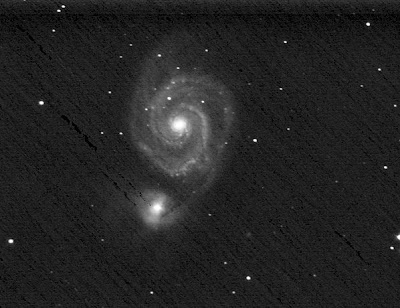The sky was clear, the air was cold, the scope was nearly perfectly aligned and focused ... and I made a rookie mistake. I was so eager to start imaging that I neglected to take fresh darks*, relying instead on darks taken a few nights before. Problem was, those darks were taken during a much warmer night and contained a lot more noise. Meade's Envisage software automatically subtracts darks from each image in a stack during the image process. Unfortunately, the effect of my error was only visible during post-session processing, not as the images piled up on the laptop's screen. When I processed the raw images, I realized the error and wanted to kick myself for ruining what would have been some nice images.
The following images are the highlights of the evening. The graininess and drizzle-like noise obvious across each image is a result of using the wrong darks.
*Dark frames, for those unacquainted with the term, are images taken with a CCD camera with the telescope tube closed. With no light coming into the tube, the image should be perfectly dark (hence the name). However, heat from the camera's chip produces a faint glow that registers on the chip's sensors (along with artifacts resulting from the heat or dead pixels). The object of taking darks is to subtract them from images taken with the telescope tube open, thus removing the glow from the camera's own heat from the final image (darks also help remove dead pixels and other noise from final images). Because the extent to which the camera's internal heat will affect an image varies with the ambient heat around the camera – i.e., whether it is 5 degrees or 50 degrees outside – darks should be taken at the start of each imaging session to best mitigate camera noise in the final image.
M97
A planetary nebula in Ursa Major (the Big Dipper). A planetary nebula is a cloud of gas and dust created when a star blows off its outer layers in an explosion called a nova near the end of its life. The star's shrunken core remains as a white dwarf star, illuminating the nebula from within. Planetary nebulae are so named because they appear generally disk-shaped, and thus reminiscent of planets. Planetary nebulae can take a variety of other forms, including hourglass-like shapes, depending on their position when seen from Earth.

M97 is brighter visually (at 9.9 magnitude) than photographically (12.0 magnitude) due to its spectral composition, and is believed to have a more cylindrical shape than is apparent from Earth. The two “eyes” that gave the nebula its name are actually the poles of the bulged cylinder that is the nebula; these appear as dark spots because matter in those places is less dense. It's distance has been estimated at about 7-10,000 light years.
M63
Another chance to image the Sunflower. Too bad the image is substantially degraded by the faulty darks.
This image comprises 120, 15-second sub-exposures.
M63 was one of the earliest galaxies to be described as a “spiral nebula” by nineteenth century astronomers. At that time, scientists thought that the stars and nebulae seen in the night sky was the entire universe. Spiral nebulae were assumed to be ordinary nebula – clouds of dust and gas – albeit with a curious spiral shape that piqued the interest of observers. It was not until the early 20th century that spectrographic analysis reveal the spiral nebula for what they were: island universes of billions of suns far beyond the Milky Way.
M63 is part of the same galaxy group as M51 and lies about 37 million light years away in the constellation of Canes Venatici.
M51
Popularly known as the Whirlpool Galaxy because of its magnificent, sweeping spiral arms, M51 was discovered by Charles Messier in 1773. But Messier's telescope didn't have optics good enough to reveal anything more than dim fuzzy cloud. It fell to Irish astronomer William Parsons (the third Earl of Rosse – usually noted as Lord Rosse) to first detect and sketch the “nebula's” spiral structure with his 36 inch reflector in 1845.
M61
One of the larger galaxies in the Virgo Cluster, M61 has a diameter estimated at 100,000 – similar to the Milky Way. It is a spiral galaxy and astronomers put its distance at 60 million light years.



No comments:
Post a Comment